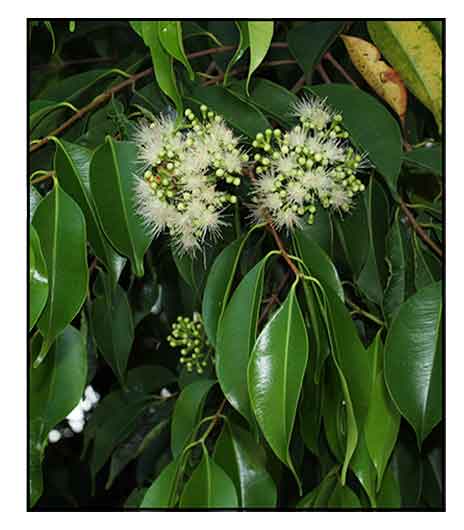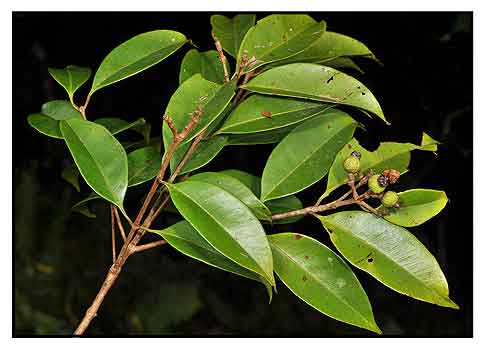
Family • Myrtaceae
Lubeg
Syzygium cerasiforme (Blume) Merr. & L.M.Perry
PHILIPPINE CHERRY
Chuang hua pu tao
| Scientific names | Common names |
| Clavimyrtus latifolia Blume | Lagi-lagi (Tag.) |
| Clavimyrtus lineata (DC.) Blume | Lubeg (Apayao) |
| Clavimyrtus symphytocarpa Blume | Malatambis (Tag.) |
| Eugenia cerasiformis (Blume) DC. | Malubeg (Apayao) |
| Eugenia lineata (DC.) Duthie | Common kelat (Engl.) |
| Eugenia longicalyx Ridl. | Philippine cherry (Engl.) |
| Eugenia longiflora (C.Presl.) Fern.-Vill. | |
| Eugenia marivelesensis Merr. | |
| Eugenia miquelii Elmer | |
| Eugenia rubricaulis (Miq.) | |
| Eugenia teysmanmii (Miq.) Koord. & Valeton | |
| Jambosa cerasiformis (Blume) Hassk. | |
| Jambosa latifolia (Blume) Miq. | |
| Jambosa lineata DC. | |
| Jambosa rubricaule Miq. | |
| Jambosa symphytocarpa (Blume) Korth ex Miq. | |
| Jambosa teysmanmii Miq. | |
| Myrtus cerasiformis Blume | |
| Myrtus lineata Blume | |
| Syzygium cerasiforme (Blume) Merr. & L.M.Perry. | |
| Syzygium lineatum (DC.) Merr. & L.M.Perry. | |
| Syzygium longicalyx (Ridl.) Massam. | |
| Syzygium longiflorum C.Presl | |
| Syzygium teysmanmii (Miq.) Massam. | |
| Syzygium cerasiforme (Blume) Merr. & L.M.Perry is an accepted name. KEW: Plants of the World Onliine | |
| Other vernacular names |
| BORNEO: Galam, Obah. |
| CAMBODIA: Pring, Pring chan, Pring phnom. |
| CHINA: Chang hua pu tao. |
| INDONESIA: Kayu udang. |
| JAVA: Gelam, Ki sireum,, Nagasari. |
| MALAYSIA: Kayu kelat, Kelat puteh, Sekujah. |
| THAILAND: Daeng song plucak, Khi tai, Phung kha. |
| VIETNAM: Tram ba vo, Tram hang, Tram khe. |
Botany Syzygium lineatum is a tree. Branchlets blackish brown when dry, terete; old branches grayish white. Petiole 1-1.2 cm; leaf blade elliptic to ovate-elliptic, 6-8 × 2.5-3.5 cm, leathery, abaxially slightly colored when dry, adaxially dark brown and glossy when dry, abaxially with numerous glands, adaxially with small glands, secondary veins dense, ca. 1 mm apart, at an angle of ca. 75° from midvein, abaxially visible but slender, and adaxially inconspicuous, intramarginal veins less than 1 mm from margin, base wide and obtuse, apex acuminate and with a 1-1.5 cm cusp. Inflorescences terminal, paniculate cymes, 8-10 cm, 3-branched, many-flowered. Flower buds pyriform, 6-7 mm. Hypanthium obconic, ca. 5 mm. Calyx lobes semiorbicular, short. Petals distinct, ovate, ca. 3 mm. Stamens 5-7 mm. Style 6-7 mm. Fruit ellipsoid, ca. 1 cm. (Flora of China)
Constituents Properties Studies Availability |
Updated May 2023 / February 2023
March 2022
![]()
 |
PHOTOS / ILLUSTRATIONS |
| IMAGE SOURCE: Photo / : Syzygium lineatum / Infructescence / Copyright © 2018 by P.B. Pelser & J.F. Barcelona (contact: [email protected]) [ref. DOL129283] / Non-Commercial Use / click on image to go to source page / Phytoimages.siu.edu |
| OTHER IMAGE SOURCE: Photo : Syzygium lineatum / Infructescence / Copyright © 2018 by P B Pelser & J F Barcelona teve (contact: [email protected]) [ref. DOL129242] / Non-Commercial Use / click on image to go to source page / Phytoimages.siu.edu |
| OTHER IMAGE SOURCE: Photo : Syzygium lineatum / Flowering branch / Copyright © 2018 by Loupok / CC BY-NC-ND / Non-Commercial Use / click on image to go to source page / Useful Tropical Plants |
Additional
Sources and Suggested Readings |
• |
DOI: It is not uncommon for links on studies/sources to change. Copying and pasting the information on the search window or using the DOI (if available) will often redirect to the new link page. (Citing and Using a (DOI) Digital Object Identifier) |
| List of Understudied Philippine Medicinal Plants |
• |
 |




